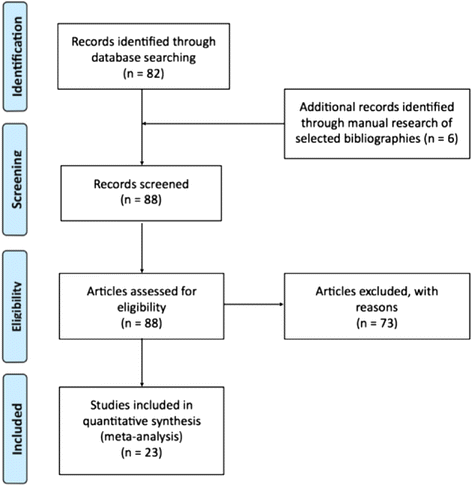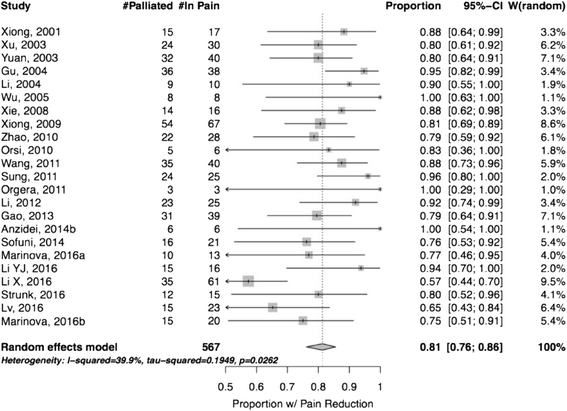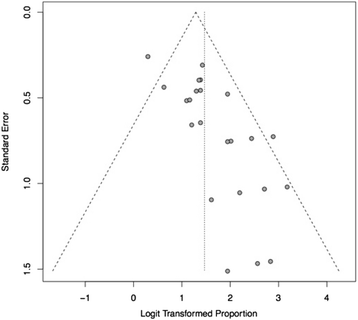A meta-analysis of palliative treatment of pancreatic cancer with high intensity focused ultrasound
- PMID: 28373906
- PMCID: PMC5376281
- DOI: 10.1186/s40349-017-0080-4
A meta-analysis of palliative treatment of pancreatic cancer with high intensity focused ultrasound
Abstract
Background: Pancreatic adenocarcinoma is currently the fourth-leading cause of cancer-related death. Up to 60-90% of patients with advanced disease suffer cancer-related pain, severely impacting their quality of life. Current management involves primarily pharmacotherapy with opioid narcotics and celiac plexus neurolysis; unfortunately, both approaches offer transient relief and cause undesired side-effects. High intensity focused ultrasound (HIFU) is a non-invasive thermal ablation technique that has been used to treat pancreatic cancer. This meta-analysis aims to evaluate the role of HIFU in pain palliation of advanced unresectable pancreatic adenocarcinoma.
Methods: An electronic search was performed in PubMed Medline database up to the end of July 2016, for unresectable pancreatic cancer pain palliation with HIFU. Pertinent studies were identified through the PubMed search engine using the following keywords: HIFU, pancreas, pancreatic cancer, pain and palliation. Additional studies were included after manual search of the selected bibliographies. Pain palliation results reported in each study were analyzed using a logit-transformed random-effects model using the inverse variance method, with the DerSimonian-Laird estimator for τ2, and Cochran's Q test for heterogeneity among studies. The I2 was calculated to assess the percentage of the total variability in the different effect size estimates that can be attributed to heterogeneity among the true effects. A rank correlation test of funnel plot asymmetry was done to assess possible publication bias.
Results: The meta-analysis includes a total number of 23 studies with 865 patients, 729 with pancreatic cancer. The population enrolled ranges from 3 patients in the smallest series, up to 61 in the largest study. τ2 (variance among studies) was 0.195, and I2 (percentage of variation among studies) was 40% (95% CI: 1-64%); the Q test p-value was 0.026, indicating significant heterogeneity among studies. Among 639 patients treated with HIFU, 567 complained of pancreatic pain before the treatment and 459 patients experienced partial or complete pain relief after treatment. The random effects estimate of the proportion of patients with pain reduction was 0.81 (95% CI: 0.76-86).
Conclusions: HIFU appears to be an effective tool for pain palliation in advanced pancreatic cancer. Studies assessing treatment in patients with pancreatic adenocarcinoma are limited by factors such as small sample sizes and heterogeneity in clinical definitions and assessments. Prospective randomized and standardized studies are necessary to confirm the effectiveness of HIFU in relieving pain, and to evaluate for any potential impact on tumor control and patient survival.
Keywords: HIFU; High intensity focused ultrasound; Meta-analysis; Non-invasive treatment; Pain palliation; Pain relief; Pancreatic cancer.
Figures



Similar articles
-
High-intensity focused ultrasound (HIFU) for pancreatic carcinoma: evaluation of feasibility, reduction of tumour volume and pain intensity.Eur Radiol. 2016 Nov;26(11):4047-4056. doi: 10.1007/s00330-016-4239-0. Epub 2016 Feb 17. Eur Radiol. 2016. PMID: 26886904
-
Advanced Pancreatic Cancer: High-Intensity Focused Ultrasound (HIFU) and Other Local Ablative Therapies.Rofo. 2019 Mar;191(3):216-227. doi: 10.1055/a-0820-5564. Epub 2019 Jan 31. Rofo. 2019. PMID: 30703824 Review. English, German.
-
Improving quality of life in pancreatic cancer patients following high-intensity focused ultrasound (HIFU) in two European centers.Eur Radiol. 2021 Aug;31(8):5818-5829. doi: 10.1007/s00330-020-07682-z. Epub 2021 Jan 23. Eur Radiol. 2021. PMID: 33486605
-
[High-intensity focused ultrasound (HIFU) for tumor pain relief in inoperable pancreatic cancer : Evaluation with the pain sensation scale (SES)].Schmerz. 2017 Feb;31(1):31-39. doi: 10.1007/s00482-016-0140-7. Schmerz. 2017. PMID: 27402264 German.
-
Technique Success, Technique Efficacy and Complications of HIFU Ablation for Palliation of Pain in Patients With Bone Lesions: A Meta-Analysis of 28 Feasibility Studies.Ultrasound Med Biol. 2021 May;47(5):1182-1191. doi: 10.1016/j.ultrasmedbio.2021.01.018. Epub 2021 Feb 11. Ultrasound Med Biol. 2021. PMID: 33583637
Cited by
-
Percutaneous Management of Cancer Pain.Curr Oncol Rep. 2020 Apr 16;22(5):43. doi: 10.1007/s11912-020-00906-x. Curr Oncol Rep. 2020. PMID: 32297006 Review.
-
Ultrasound-guided percutaneous procedures in pancreatic diseases: new techniques and applications.Eur Radiol Exp. 2019 Jan 22;3(1):2. doi: 10.1186/s41747-018-0081-2. Eur Radiol Exp. 2019. PMID: 30671676 Free PMC article. Review.
-
Multiparameter Magnetic Resonance Quantitative Evaluation of Pancreatic Cancer with Vascular Invasion.Biomed Res Int. 2022 Apr 19;2022:4370341. doi: 10.1155/2022/4370341. eCollection 2022. Biomed Res Int. 2022. Retraction in: Biomed Res Int. 2023 Nov 29;2023:9806925. doi: 10.1155/2023/9806925. PMID: 35496056 Free PMC article. Retracted.
-
Focused ultrasound for immuno-adjuvant treatment of pancreatic cancer: An emerging clinical paradigm in the era of personalized oncotherapy.Int Rev Immunol. 2017 Nov 2;36(6):338-351. doi: 10.1080/08830185.2017.1363199. Epub 2017 Sep 29. Int Rev Immunol. 2017. PMID: 28961038 Free PMC article. Review.
-
Pancreas Cancer-Associated Pain Management.Oncologist. 2021 Jun;26(6):e971-e982. doi: 10.1002/onco.13796. Epub 2021 May 12. Oncologist. 2021. PMID: 33885205 Free PMC article. Review.
References
-
- NIH. Available online: http://seer.cancer.gov/statfacts/html/pancreas.html (accessed on 8 Oct 2016).
-
- Smyth E, Cunningham D. Pancreatic cancer. Harrison’s Principles Int Med. 2015;2(19th):554–7.
Grants and funding
LinkOut - more resources
Full Text Sources
Other Literature Sources

